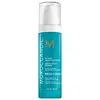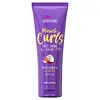What's inside
What's inside
 Key Ingredients
Key Ingredients

No key ingredients
 Benefits
Benefits

 Concerns
Concerns

 Ingredients Side-by-side
Ingredients Side-by-side

Cyclomethicone
EmollientDimethicone
EmollientPhenyl Trimethicone
Skin ConditioningBis-Vinyldimethicone
Diphenyl Dimethicone
EmollientParfum
MaskingArgania Spinosa Kernel Oil
EmollientHydrogenated Vegetable Glycerides Citrate
EmollientTocopherol
AntioxidantAscorbyl Palmitate
AntioxidantBeta-Sitosterol
Emulsion StabilisingGlyceryl Linolenate
EmollientLecithin
EmollientHydrogen Dimethicone
Squalene
EmollientPropylene Glycol
HumectantCyclomethicone, Dimethicone, Phenyl Trimethicone, Bis-Vinyldimethicone, Diphenyl Dimethicone, Parfum, Argania Spinosa Kernel Oil, Hydrogenated Vegetable Glycerides Citrate, Tocopherol, Ascorbyl Palmitate, Beta-Sitosterol, Glyceryl Linolenate, Lecithin, Hydrogen Dimethicone, Squalene, Propylene Glycol
Water
Skin ConditioningParaffinum Liquidum
EmollientGlycerin
HumectantPetrolatum
EmollientCetearyl Alcohol
EmollientCyclopentasiloxane
EmollientIsodecyl Oleate
EmollientSorbitan Stearate
EmulsifyingSimmondsia Chinensis Seed Oil
EmollientCocos Nucifera Oil
MaskingParfum
MaskingDicetyl Phosphate
EmulsifyingCeteth-10 Phosphate
CleansingParaffin
PerfumingDimethicone
EmollientPhenoxyethanol
PreservativeDecyl Oleate
EmollientTriethanolamine
BufferingPEG-100 Stearate
Glyceryl Stearate
EmollientMethylparaben
PreservativeDisodium EDTA
Propylparaben
PreservativeLysine Hcl
Skin ConditioningMethyl Tyrosinate Hcl
Water, Paraffinum Liquidum, Glycerin, Petrolatum, Cetearyl Alcohol, Cyclopentasiloxane, Isodecyl Oleate, Sorbitan Stearate, Simmondsia Chinensis Seed Oil, Cocos Nucifera Oil, Parfum, Dicetyl Phosphate, Ceteth-10 Phosphate, Paraffin, Dimethicone, Phenoxyethanol, Decyl Oleate, Triethanolamine, PEG-100 Stearate, Glyceryl Stearate, Methylparaben, Disodium EDTA, Propylparaben, Lysine Hcl, Methyl Tyrosinate Hcl
Ingredients Explained
These ingredients are found in both products.
Ingredients higher up in an ingredient list are typically present in a larger amount.
Dimethicone is a type of synthetic silicone created from natural materials such as quartz.
What it does:
Dimethicone comes in different viscosities:
Depending on the viscosity, dimethicone has different properties.
Ingredients lists don't always show which type is used, so we recommend reaching out to the brand if you have questions about the viscosity.
This ingredient is unlikely to cause irritation because it does not get absorbed into skin. However, people with silicone allergies should be careful about using this ingredient.
Note: Dimethicone may contribute to pilling. This is because it is not oil or water soluble, so pilling may occur when layered with products. When mixed with heavy oils in a formula, the outcome is also quite greasy.
Learn more about DimethiconeParfum is a catch-all term for an ingredient or more that is used to give a scent to products.
Also called "fragrance", this ingredient can be a blend of hundreds of chemicals or plant oils. This means every product with "fragrance" or "parfum" in the ingredients list is a different mixture.
For instance, Habanolide is a proprietary trade name for a specific aroma chemical. When used as a fragrance ingredient in cosmetics, most aroma chemicals fall under the broad labeling category of “FRAGRANCE” or “PARFUM” according to EU and US regulations.
The term 'parfum' or 'fragrance' is not regulated in many countries. In many cases, it is up to the brand to define this term.
For instance, many brands choose to label themselves as "fragrance-free" because they are not using synthetic fragrances. However, their products may still contain ingredients such as essential oils that are considered a fragrance by INCI standards.
One example is Calendula flower extract. Calendula is an essential oil that still imparts a scent or 'fragrance'.
Depending on the blend, the ingredients in the mixture can cause allergies and sensitivities on the skin. Some ingredients that are known EU allergens include linalool and citronellol.
Parfum can also be used to mask or cover an unpleasant scent.
The bottom line is: not all fragrances/parfum/ingredients are created equally. If you are worried about fragrances, we recommend taking a closer look at an ingredient. And of course, we always recommend speaking with a professional.
Learn more about Parfum